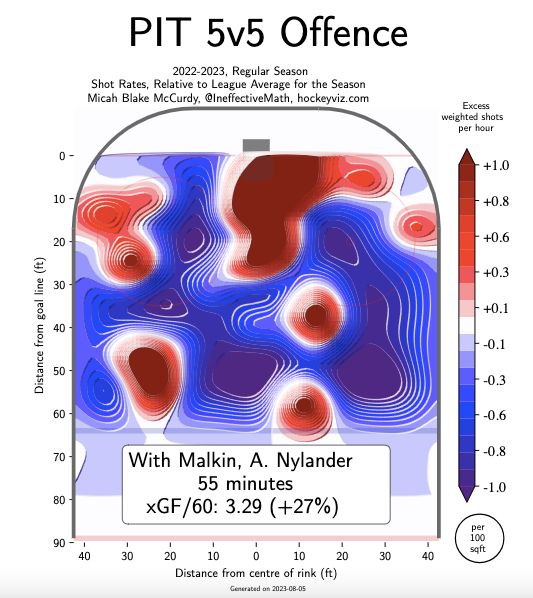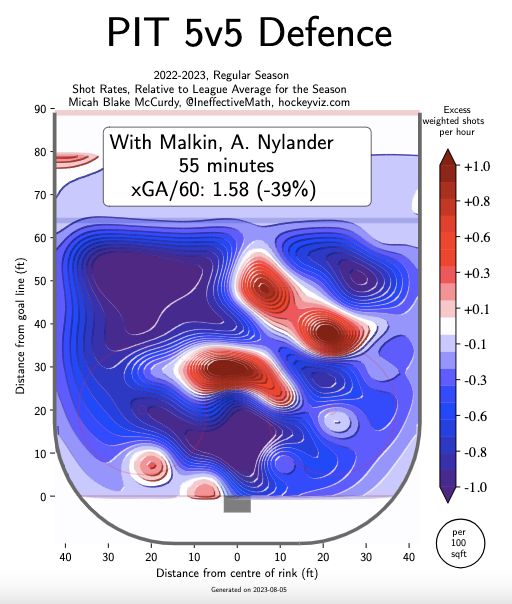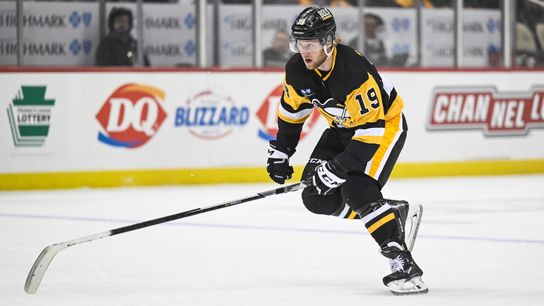The Penguins will be without Jake Guentzel for some time to start the season.
Guentzel underwent right ankle surgery on Aug. 2 and will be re-evaluated in 12 weeks, Kyle Dubas announced on Friday morning.
Guentzel's injury was a nagging injury that he sustained prior to this offseason -- no, not in Da Beauty League -- and there was hope that Guentzel would be able to rehab his injury without needing surgery. But once he started getting back on the ice in preparation for the coming season, it became clear that surgery would be required.
"As Jake continued to increase the intensity of his preparation for the upcoming season, it was apparent that his ankle injury was not resolving in a way that was satisfactory to he or the Penguins," Dubas said in a team release. "In collaboration with Jake - his representative Ben Hankinson of Octagon Sports, the Penguins medical team led by Dr. Dharmesh Vyas of UPMC Sports Medicine, and Dr. Chris Coetzee - it was decided that surgery would be the best way to ensure Jake would be at his best in 2023-2024."
It seems possible that Guentzel's injury stems from a blocked shot on March 22 in Colorado. He was immediately felled near the blue line by the shot hitting his right ankle and had to go to the bench, though he didn't leave the game:
— DK Pittsburgh Sports (@DKPSvideos) August 5, 2023
Guentzel's right ankle was wrapped in a big ice bag after the game. He was deemed a game-time decision the following day in Dallas, and the Penguins recalled Filip Hallander on an emergency basis. Hallander wasn't there in Dallas by the start of the game, and Guentzel ended up feeling OK enough to play.
Guentzel was expected to play in the World Championship this summer -- he said that much himself on the Penguins' cleanout day, and head coach David Quinn had publicly acknowledged Guentzel's involvement as well. Guentzel ultimately pulled out of the tournament before rosters were announced, likely because of his nagging ankle injury.
There's been some misguided hand-wringing from fans over Guentzel's involvement in Da Beauty League despite his ankle injury, which is silly. Da Beauty League is a glorified summer skate, no different than the small group skates every NHL player participates in to keep in shape over the offseason. The fact that the "league" is somewhat more structured and marketed to fans doesn't make it any more taxing or dangerous than something like Sidney Crosby's skates and pickup games with the Nova Scotia pros he skates with every summer. Anyone who has watched the games can see that the intensity and effort isn't anything close to a real game. It's a summer skate. Even so, Guentzel wasn't a full participant. He was a late commitment to the league this summer and only played in three of his team's five games. If anything, Guentzel's participation is what allowed him to realize that things weren't quite right with his ankle. As Dubas acknowledged, it became apparent that surgery would be required only after Guentzel started increasing the intensity of his preparations for the season.
Guentzel's timeine would have him sidelined until at least Oct. 25, which is about when he is expected to be re-evaluated. That alone would have him missing the Penguins' first six games of the season, and it would be reasonable to expect that he would need more time than that to be ready for a return after missing all of training camp and being off the ice as long as he will be.
Long-term injured reserve seems like a likely option for Guentzel, but it isn't a given. Putting Guentzel on long-term injured reserve would both free up a roster spot and provide the Penguins salary-cap relief on Guentzel's $6 million cap hit, but it would require him to miss at least the first 10 games and 24 days (whichever is longer) to start the season. That timeline would require him to be out until at least Nov. 7 in Anaheim. That salary-cap relief would only be temporary for as long as Guentzel would be on long-term injured reserve, and the Penguins would have to get cap-compliant again in order to activate him. Guentzel temporarily going on long-term injured reserve wouldn't help the Penguins with any longer-term cap concerns for the season. That means that it isn't feasible to replace Guentzel with an outside option, because he's expected to be back this season and the Penguins would lose that cap relief once he returns.
Assuming that the top six looks something like this when Guentzel is healthy...:
Jake Guentzel - Sidney Crosby - Rickard Rakell
Reilly Smith - Evgeni Malkin - Bryan Rust
... there is now an opening for a winger somewhere in that top six to start the season. That doesn't necessarily have to be on the left side, since Rakell is able to shift over to the left side. The opening doesn't have to be for Crosby's wing either, since Smith or Rust would presumably get bumped up there first.
The Penguins will surely try out a number of combinations in the top six when training camp opens on Sept. 21. In the meantime, let's take a look at a handful of players who may benefit from an opportunity in the top six created by Guentzel's absence.
ALEX NYLANDER
Nylander has experience on Malkin's wing, albeit in a short sample size.
Nylander was recalled to the NHL for nine games last season, and picked up a goal and an assist in that time. His total ice time at five-on-five was pretty evenly split between the second line and the bottom six, with 55 minutes alongside Malkin and 54 minutes in the bottom six.
Nylander, 25, fared well with Malkin on the second line. When the two were together on the ice, the Penguins controlled 58.97% (69-48) of the shot attempts, 58.90% (43-30) of all unblocked shot attempts, and 64.52% (20-11) of all high-danger shot attempts. They outscored opponents 3-2, with all goals in either direction coming from the high-danger areas of the ice.
The Penguins' expected goals for every 60 minutes of five-on-five ice ice time with Nylander and Malkin together was 3.29, or 27% higher than league average. This chart from HockeyViz shows where exactly all those attempts were coming from, with red areas showing where there was a rate shot attempts higher than the league average, and blue areas showing where attempts were below league average:

HockeyViz.com
That didn't come at the expense of poor play on the other side of the puck, despite being deployed against some high-end talent. Nylander's most frequent forward opponents while with Malkin were Patrick Kane (9 minutes), Artemi Panarin and Vince Trocheck (both 7 minutes). When Nylander and Malkin were together, the Penguins' expected goals against per 60 minutes of five-on-five ice time was 1.58, or 39% below league average. The colors of this chart from HockeyViz mean the same as the above, but in this case blue is good because it shows were shots were suppressed below league average:

HockeyViz.com
I spoke one-on-one with Nylander after one of those games on Malkin's wing last season and asked if anything changes for him when he's in a role like that.
"You just have to be more aware," he said. "They can pass to you wherever you are. You just have to be aware whenever they have the puck. Obviously I want to work hard and get the puck to them and get open, and if I play my game I think we'll connect good."
Nylander can score, that's certain. He had the highest rate of points-per-game among regular players on Wilkes-Barre/Scranton last season with .91, or 25 goals and 25 assists in 55 games. Those 35 goals also led the team. The points didn't come as quickly in his NHL games, but with the games coming fairly spread out and with a rotating cast of linemates, he didn't exactly have a great opportunity to settle in. Still, he acknowledged that he needed to shoot more in those games.
"Especially today, I think I need to get more shots," he told me after a game in which he spent time on Malkin's wing. "I had a couple of chances last game that I played. But today I just have to get more pucks to the net and create more chances like that. But we had some good O-zone shifts. I just have to hold onto the puck a little more than I've been doing and getting more shots to the net."
Nylander would make for a pretty good candidate to earn some time back on Malkin's wing with Guentzel out. With Nylander being a right wing, it would require a bit of shuffling, like moving Rust up to first-line right wing and shifting Rakell over to Crosby's left.
VALTTERI PUUSTINEN
Puustinen, 24, was Wilkes-Barre's leading scorer last year with 24 goals and 35 assists in 72 games. That's a decent increase from his rookie year totals of 20 goals and 22 assists in 73 games.
Puustinen didn't get a shot in the NHL last season. Not one. Not even a call up to practice with the team and not play. Part of that was the cap constraints that limited the Penguins for much of that season, but part of that was also just because of Puustinen's role. He's not a bottom-six player. He's 5-9 and 183 pounds and doesn't have any kind of physical presence, and while his two-way game is decent, he didn't have the defensive presence of someone like Filip Hallander or Jonathan Gruden who each got a couple of games in on the bottom six.
With an opportunity now open in the top six, this might be the time to finally see what Puustinen can do with an extended look in the NHL.
Puustinen does have a little bit of experience playing with Crosby. In the opening days of training camp, when all the depth players and prospects are mixed in with the group, the Penguins don't skate with their expected line combinations. Mike Sullivan likes to take a pair of expected forwards, like Guentzel-Crosby, and put them with a third player who might not be on the NHL roster to start the season. That was the case with Puustinen last training camp, as he opened camp with Crosby and Guentzel.
"He's skilled, he's got great hands," Crosby told me of his initial impressions of Puustinen. "He's able to see the ice. Hopefully we get better every day."
Puustinen had a big grin on his face when asked about the experience.
"Awesome," Puustinen said of playing with Crosby. "I liked it, and I tried my best. (Sid) said, 'Good luck,' and with passing, if I made a not good pass he said 'Whatever, whatever, keep going, keep going.' I tried my best and he's an awesome guy. I'm very, very happy."
Puustinen, a right-handed shot, is capable of playing on both wings, but he's far more comfortable on the right side. He played both sides in Finland before making the jump to North America, and played exclusively the right side in his rookie year in Wilkes-Barre. He was shifted over to the left for a handful of games last season when Wilkes-Barre's lineup was shuffled around due to injuries and recalls, but he didn't last there very long. If he were to break into the NHL, it would surely be on his natural right side, so it would require the same shuffling as Nylander would require in the top six.
DREW O'CONNOR
If the Penguins are looking for some youth in the top six and a natural left-handed left wing that wouldn't force anyone else to play on their off side, O'Connor could be a natural fit. He could slot right into Guentzel's spot, or next to Malkin with Smith getting bumped up to Crosby's wing. Rakell and Rust could then play their natural sides.
O'Connor, 25, will be entering his fourth pro season with the Penguins after signing a two-year contract this week that carries a $925,000 cap hit. Because he has accrued three seasons, next year will be the first year in which he loses his waivers-exempt status and would require waivers to be sent down to the AHL. He'll look to stick in the NHL full-time for the first time in his career after splitting his first three years between Pittsburgh and Wilkes-Barre.
Beyond filling in for a couple of practices or some overlap during line changes in games, O'Connor hasn't played in the top six before. He played with Rakell in training camp last year during those early days when Sullivan puts younger depth players with NHL regulars for a few practices.
O'Connor has produced at exactly a point-per-game over his three years in the AHL. He had 22 points (eight goals, 14 assists) in 20 games last year, and 32 points (12 goals, 20 assists) in 33 games the year before. In his rookie 2019-20 season, he recorded 19 points (7 goals, 12 assists) in 20 games.
O'Connor put up OK numbers during his time in the NHL last season, with five goals and six assists in 46 games. That's was in primarily a fourth-line role, averaging 9:49 minutes per night, with his most frequent linemates at five-on-five being Jeff Carter and Josh Archibald. He also got more shift starts in the defensive zone, with 5.41 offensive zone starts per 60 minutes of five-on-five ice time and 12.25 defensive zone starts for every 60 minutes of five-on-five ice time. That's not exactly an environment conducive to scoring.
It would be interesting to see what O'Connor could do with more minutes in a more offensive role.
MIKAEL GRANLUND
Granlund? Really?
If Granlund is still on the team on opening night -- and that's not a given, especially since a buyout Sunday could clear over $4.1 million in cap space -- he could be an option to temporarily step into the top six.
Obviously, Granlund didn't put up the points in Pittsburgh after being acquired from Nashville, with only a goal and four assists in 21 games. That's quite the drop off from his nine goals and 27 assists in 58 games prior to the trade, or his 11 goals and 53 assists in 80 games the year before.
But Granlund's role in Pittsburgh was a bit different from the top-six role he had in Nashville, having more defensive and penalty-killing responsibilities. He did fare well in those areas too, as the on-ice metrics show. After the final practice of the season, I asked Granlund how he'd assess his play since the trade, in particular with the lack of scoring.
"It's a role I've been playing," Granlund told me. "There's a lot of defensive responsibilities, PK and all that. I'm kind of happy with how I've done in those situations. Obviously, you'd like to get scoring and all that too, but you always have to remember the role you're playing and the situations you're out there. I think I've done a good job. You'd like to give even more to the team scoring-wise, but we'll see what's going to happen."
Granlund, a left-handed shot, has experience playing both wings and extensive top-six experience in his career. If he doesn't get bought out or traded in an effort to clear as much of his $5 million cap hit as possible before the start of the season, it might be worth seeing how he fares in a more offensive role than he had in the second half of last season.


